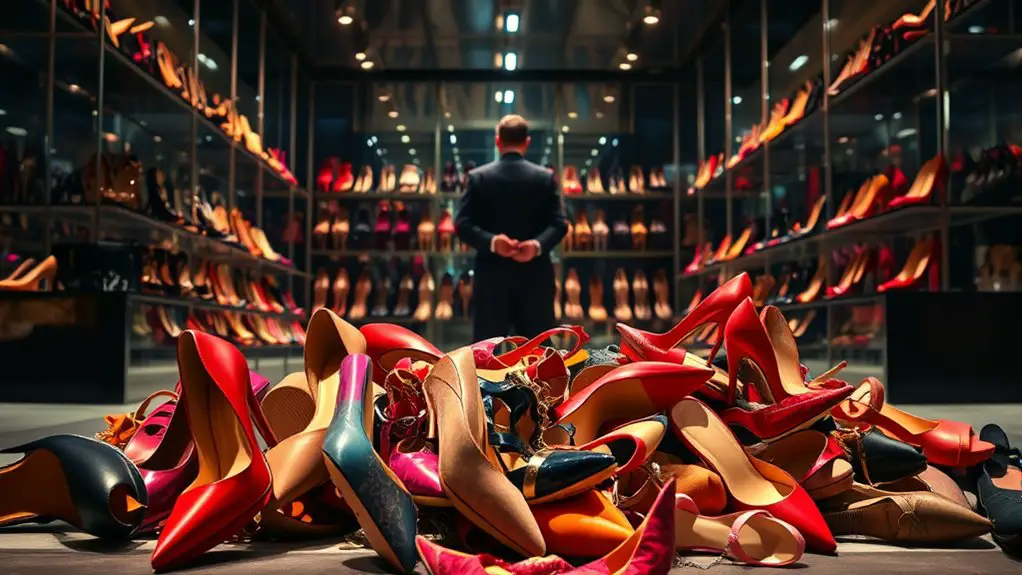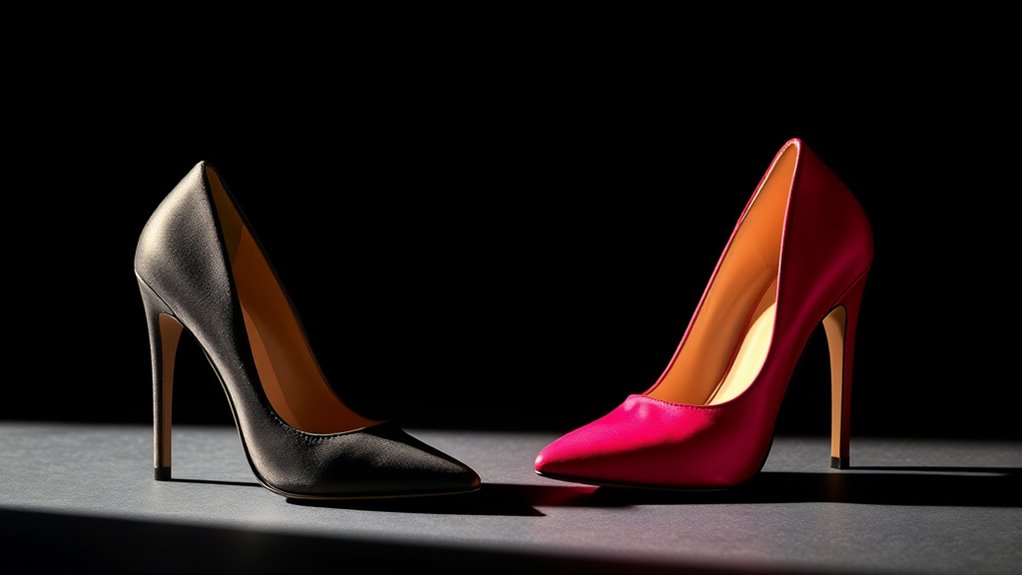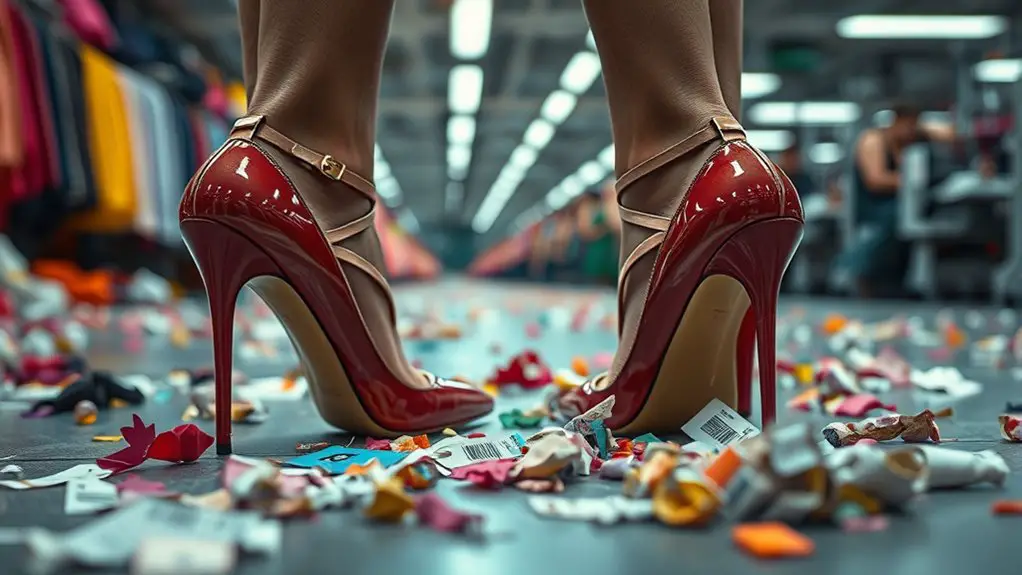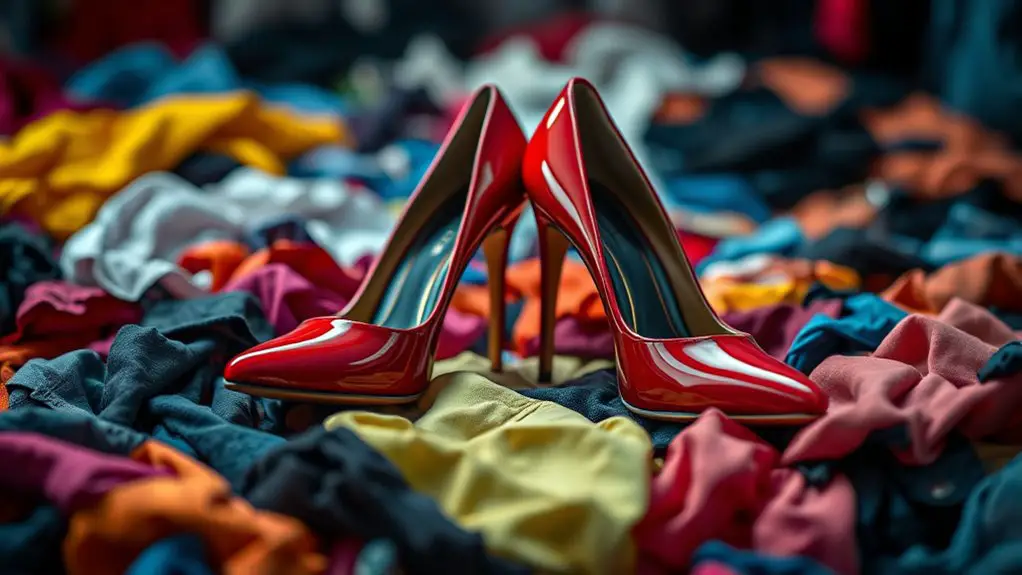Fast fashion dramatically reshapes the high heel industry by prioritizing trendy designs over quality craftsmanship. Quick production cycles lead to a constant influx of new styles, often sacrificing durability for affordability. This creates a closet full of quickly outdated shoes, fueling a disposable mindset. As consumer awareness grows around ethical sourcing and sustainability, brands are under pressure to adapt. If you explore further, you’ll uncover how these shifts influence both today’s trends and the future of high heels.
The Rise of Fast Fashion in Footwear

As consumers increasingly seek trendy yet affordable options, the rise of fast fashion in footwear has transformed how we view and purchase shoes. This shift is largely driven by consumer demand for stylish yet budget-friendly footwear, which has propelled brands to adapt quickly. Fast fashion companies thrive on production speed, allowing them to churn out new styles in a matter of weeks rather than months. This rapid turnaround means you’re often left with an ever-evolving selection, making it easier to keep your wardrobe fresh.
However, this model raises questions about quality and sustainability. While you may enjoy the latest trends at a lower price, it’s essential to reflect on the environmental impact of such a consumption pattern. Fast fashion often prioritizes quantity over craftsmanship, leading to a disposable mindset. So, as you embrace this trend, think about how it aligns with your values and long-term wardrobe choices.
Trends Driving High Heel Production
While fashion trends evolve rapidly, high heels continue to hold a significant place in the footwear market due to their association with elegance and empowerment. Current trends driving high heel production reflect shifting consumer demand and the fast fashion industry’s relentless pace. As fashion cycles shorten, brands face intense price competition, pushing them to innovate materials and design efficiently. Seasonal trends, often amplified by influencer collaborations, propel styles that resonate with consumers, fostering brand loyalty amid market saturation. High-end and budget brands alike are responding to these demands by creating limited-edition collections that capitalize on viral trends. Material innovation plays a vital role as well, with brands experimenting with sustainable options to attract eco-conscious shoppers. Ultimately, the interplay of these trends shapes the high heel landscape, ensuring that even as preferences shift, the allure of high heels remains strong and relevant in today’s market.
Impact on Design Aesthetics and Innovation

In today’s fast fashion landscape, you’re likely noticing how trends often overshadow timeless designs in the high heel industry. This shift not only affects aesthetics but also raises questions about the balance between sustainability and style. As you explore these dynamics, consider how innovation might be sacrificed in the pursuit of fleeting popularity.
Trends Over Timelessness
Though the allure of high heels often lies in their timeless elegance, the fast fashion industry’s relentless pursuit of trends has greatly reshaped the design aesthetics and innovation within this sector. This shift prioritizes fleeting trends over enduring style, leading to:
- Rapid design cycles that prioritize speed over quality.
- An explosion of bold, experimental styles that may not age well.
- A focus on affordability at the expense of craftsmanship.
- Increased consumer demand for variety, often leading to impulsive purchases.
As you navigate this landscape, it’s essential to recognize how these trends impact your choices. While you may be tempted by the latest designs, remember that true elegance often comes from pieces that withstand the test of time.
Sustainability vs. Style
As the conversation around sustainability gains momentum, the high heel industry faces a pivotal crossroads between maintaining style and embracing eco-friendly practices. You might wonder how designers can balance the allure of high fashion with the need for sustainable materials. The challenge lies in reimagining aesthetics without compromising on ethics. Innovative brands are now prioritizing ethical production methods, using materials like recycled plastics and organic textiles, which not only reduce environmental impact but also offer unique textures and colors. This shift encourages creativity, pushing designers to think outside traditional confines. Ultimately, you’re likely to see a new wave of high heels that merge sustainability with stunning design, appealing to conscious consumers who crave both style and responsibility in their footwear choices.
Quality vs. Quantity: The Trade-Offs
While the allure of fast fashion may tempt you with its low prices and trendy designs, the underlying trade-offs between quality and quantity can’t be ignored. As you navigate this industry, consider the following impacts:
- Craftsmanship Decline: Fast fashion prioritizes mass production over skilled craftsmanship, leading to shoes that lack the intricate details and quality you might expect.
- Durability Concerns: Lower-quality materials mean that high heels may not withstand regular wear, resulting in more frequent replacements.
- Cost Per Wear: Investing in quality often means a higher initial cost, but it can save you money in the long run through increased durability.
- Trendy vs. Timeless: Fast fashion encourages chasing trends, which can lead to a closet full of shoes that quickly go out of style, further emphasizing quantity over lasting value.
Ethical Considerations in Fast Fashion

When reflecting on the fast fashion industry, it’s essential to examine the ethical implications that come with the rapid production of high heels. The pressure for quick turnaround times often leads brands to overlook ethical sourcing and labor practices. You might be surprised to learn that many manufacturers cut corners, resulting in unfair wages and poor working conditions for laborers.
As a consumer, your awareness of these issues can drive change. By demanding brand transparency, you’re advocating for responsible production and the use of sustainable materials. The environmental impact of fast fashion is staggering; it’s not just about style but also about the legacy we leave behind.
When you choose high heels from brands that prioritize ethical practices, you contribute to a movement that values both fashion and fairness. Your choices can inspire others to reflect on the broader implications of their purchases, fostering a more conscientious fashion landscape.
Sustainability Challenges in High Heel Manufacturing
Although the allure of high heels remains strong, the sustainability challenges in their manufacturing process are becoming increasingly apparent. As consumers grow more conscious of their environmental impact, the high heel industry must address several vital issues:
- Eco-friendly materials: Traditional materials often come from unsustainable sources, making it essential to explore alternatives like recycled plastics or organic textiles.
- Production waste: The high heel manufacturing process generates significant waste, which could be reduced through better design and production methods.
- Ethical labor practices: Ensuring fair labor conditions is vital in sustainable manufacturing, yet many brands struggle to comply.
- Longevity: Fast fashion promotes disposable trends, leading to short product lifespans. Focusing on durability can help combat this issue.
Consumer Behavior and Fast Fashion
The growing awareness of sustainability in high heel manufacturing is closely tied to shifts in consumer behavior, particularly in relation to fast fashion. Today, you’re likely influenced by seasonal trends that prioritize style over longevity. Your purchasing habits reflect a desire for affordable options, but this price sensitivity can undermine brand loyalty. Fast fashion’s rapid fashion cycles encourage you to buy frequently, often at the expense of quality and ethical considerations.
As you engage in online shopping, marketing strategies focus on promoting the latest styles, leaving little room for reflection on social responsibility. Consumer preferences are shifting, demanding brands align with values of sustainability and ethical practices. Consequently, high heel manufacturers must adapt their offerings to resonate with your evolving expectations. Ultimately, your choices can drive the industry towards more responsible production, emphasizing the power of informed consumer behavior in shaping a sustainable future.
The Role of Social Media in High Heel Trends
Social media serves as a powerful catalyst in shaping high heel trends, influencing your choices and preferences in unprecedented ways. The impact of influencers and viral styles can’t be underestimated; they create a fast-paced environment where trends emerge and evolve rapidly. Here are some key ways social media shapes high heel trends:
- Influencer Impact: Influencers showcase high heels in curated outfits, making them desirable and aspirational.
- Viral Styles: A pair of heels can go viral overnight, driven by likes, shares, and comments across platforms.
- User-Generated Content: You’re likely to see everyday users flaunting their high heels, creating relatable style inspiration.
- Trend Cycles: Trends can shift quickly, with social media allowing for instant feedback and adaptability in designs.
As you navigate this landscape, keep an eye on how these elements converge to redefine your expectations and choices regarding high heels.
Future Outlook for the High Heel Industry
As trends continue to evolve, the high heel industry faces a pivotal moment that could redefine its future. Market adaptation is essential, as consumer preferences shift towards sustainability and ethical production. Brands must demonstrate resilience by embracing eco-friendly materials and innovative designs. Future innovations could include technology integration, such as 3D-printed heels that cater to individual comfort and style evolution.
Moreover, design collaborations with influencers or artists can create buzz and attract a diverse consumer base. Pricing strategies will also need to be re-evaluated; balancing quality with affordability is key to retaining loyal customers. As you navigate this changing landscape, keep an eye on how brands respond to these challenges. The high heel industry can thrive by aligning with modern values and embracing a forward-thinking approach, ensuring it remains relevant in a fast-paced fashion world.
Frequently Asked Questions
How Do High Heel Brands Compete With Fast Fashion Retailers?
In a sea of trends, high heel brands navigate by deploying brand differentiation strategies, emphasizing unique designs and quality. They’re adopting sustainable practices, ensuring you choose style with a conscience, setting them apart from fast fashion rivals.
What Materials Are Commonly Used in Fast Fashion High Heels?
Fast fashion high heels often use synthetic materials like polyurethane and PVC for cost-effectiveness. However, you’ll find eco-friendly options emerging, such as recycled plastics and sustainable fabrics, reflecting a growing trend towards environmental awareness.
Are Fast Fashion High Heels Comfortable for Long-Term Wear?
Fast fashion high heels often compromise comfort levels for style. While they may look trendy initially, their long-term effects can lead to discomfort and foot issues, making them less suitable for extended wear than quality alternatives.
How Does Fast Fashion Affect Traditional High-End Shoe Craftsmanship?
Consider a luxury shoemaker struggling as consumer preferences shift toward trendy, inexpensive alternatives. Fast fashion’s influence compromises craftsmanship quality, pushing artisans to either adapt or risk losing their unique artistry in the face of mass production.
What Are the Financial Implications for High Heel Designers in Fast Fashion?
Fast fashion’s financial implications for high heel designers often include squeezed profit margins. When you consider designer collaborations, they might boost visibility, but the rapid production cycles can undermine the craftsmanship that traditionally defines high-end footwear.



